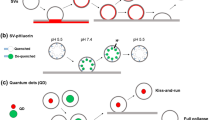Abstract
Synaptic vesicle exocytosis can be monitored with genetically encoded pH sensors in an in vitro fluorescence microscopy setup. Here, we describe a workflow starting with preparation of a primary cell culture to eventually estimate synaptic vesicle pool sizes based on electrical current-evoked vesicle release, which is reported by the synaptobrevin 2-EGFP fusion protein synapto-pHluorin (spH) that is expressed inside the synaptic vesicle membrane. The readily releasable pool and the recycling pool of synaptic vesicles are released separately in response to electrical stimulation. As vesicle reacidification is blocked in this experimental design, every released vesicle is counted only once. This spH-based approach offers different information than styryl-dye (FM dyes)-based approaches because the total synaptic pool size is measured by an alkalinization step. This provides a normalization constant for quantifying and comparing the synaptic vesicle pool sizes. In addition to investigation of basic research questions, spH-reported vesicle release is valuable to determine presynaptic effects of, e.g., pharmacological drug treatments.
Access this chapter
Tax calculation will be finalised at checkout
Purchases are for personal use only
Similar content being viewed by others
References
Ryan TA, Smith SJ (1995) Vesicle pool mobilization during action potential firing at hippocampal synapses. Neuron 14(5):983–989
Wienisch M, Klingauf J (2006) Vesicular proteins exocytosed and subsequently retrieved by compensatory endocytosis are nonidentical. Nat Neurosci 9(8):1019–1027. https://doi.org/10.1038/nn1739
Amato D, Canneva F, Cumming P et al (2020) A dopaminergic mechanism of antipsychotic drug efficacy, failure, and failure reversal: the role of the dopamine transporter. Mol Psychiatry 25(9):2101–2118. https://doi.org/10.1038/s41380-018-0114-5
Dahlmanns JK (2019) Development of quantitative functional analysis tools and models for neuroscientific applications. Dissertation; Friedrich-Alexander-Universität Erlangen-Nürnberg urn:nbn:de:bvb:29-opus4-103312
Rosenmund C, Stevens CF (1996) Definition of the readily releasable pool of vesicles at hippocampal synapses. Neuron 16(6):1197–1207
Wilhelm BG, Groemer TW, Rizzoli SO (2010) The same synaptic vesicles drive active and spontaneous release. Nat Neurosci 13(12):1454–1456. https://doi.org/10.1038/nn.2690
Atwood HL, Karunanithi S (2002) Diversification of synaptic strength: presynaptic elements. Nat Rev Neurosci 3(7):497–516. https://doi.org/10.1038/nrn876
Hua Y, Sinha R, Thiel CS et al (2011) A readily retrievable pool of synaptic vesicles. Nat Neurosci 14(7):833–839. https://doi.org/10.1038/nn.2838
Dahlmanns M, Yakubov E, Chen D et al (2017) Chemotherapeutic xCT inhibitors sorafenib and erastin unraveled with the synaptic optogenetic function analysis tool. Cell Death Discov 3:17030. https://doi.org/10.1038/cddiscovery.2017.30
Tagliatti E, Fadda M, Falace A et al (2016) Arf6 regulates the cycling and the readily releasable pool of synaptic vesicles at hippocampal synapse. eLife 5:10116. https://doi.org/10.7554/eLife.10116
Royle SJ, Granseth B, Odermatt B et al (2008) Imaging phluorin-based probes at hippocampal synapses. Methods Mol Biol 457:293–303
Sankaranarayanan S, De Angelis D, Rothman JE et al (2000) The use of pHluorins for optical measurements of presynaptic activity. Biophys J 79(4):2199–2208. https://doi.org/10.1016/S0006-3495(00)76468-X
Author information
Authors and Affiliations
Corresponding author
Editor information
Editors and Affiliations
Rights and permissions
Copyright information
© 2022 The Author(s), under exclusive license to Springer Science+Business Media, LLC, part of Springer Nature
About this protocol
Cite this protocol
Dahlmanns, M., Dahlmanns, J.K. (2022). Synaptic Vesicle Pool Monitoring with Synapto-pHluorin. In: Dahlmanns, J., Dahlmanns, M. (eds) Synaptic Vesicles. Methods in Molecular Biology, vol 2417. Humana, New York, NY. https://doi.org/10.1007/978-1-0716-1916-2_14
Download citation
DOI: https://doi.org/10.1007/978-1-0716-1916-2_14
Published:
Publisher Name: Humana, New York, NY
Print ISBN: 978-1-0716-1915-5
Online ISBN: 978-1-0716-1916-2
eBook Packages: Springer Protocols




